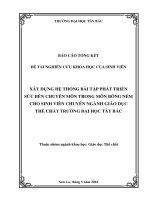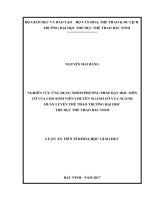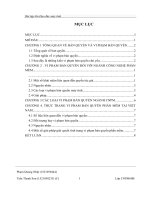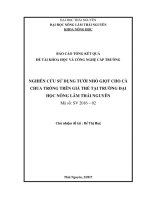Formative Assessment Issues Across the Curriculum The Theory and the Practice TRƯỜNG ĐẠI HỌC MỞ BÀI GIẢNG GIÁO TRÌNH
Bạn đang xem bản rút gọn của tài liệu. Xem và tải ngay bản đầy đủ của tài liệu tại đây (492.17 KB, 6 trang )
Leung, C. (2007). Dynamic assessment: Assessment for and as teaching. Language
Assessment Quarterly, 4, 257–278.
Poehner, M., & Lantolf, J. (2005). Dynamic assessment in the language classroom.
Language Teaching Research, 9, 233–265.
Rea-Dickins, P. (2001). Mirror, mirror on the wall: Identifying processes of classroom
assessment. Language Testing, 18, 429–462.
Rea-Dickins, P. (2007). Classroom-based assessment: Possibilities and pitfalls. In J.
Cummins & C. Davison (Eds.), International handbook of English language teaching,
Part II (pp. 505–520). New York: Springer.
Short, D., Gomez, E., Cloud, N., Katz, A., Gottlieb, M., & Malone, M. (2000). Training
others to use the ESL standards: A professional development manual. Alexandria, VA:
TESOL.
Teachers of English to Speakers of Other Languages (TESOL). (1998). ESL standards
for pre-K-12 students. Alexandria, VA: TESOL.
Winer, L. (1992). “Spinach to chocolate”: Changing awareness and attitudes in ESL
writing teachers. TESOL Quarterly, 26, 57–80.
Formative Assessment Issues Across the Curriculum:
The Theory and the Practice
PAUL BLACK
King’s College
London, England
Ⅲ In the past decade, formative assessment has attracted a good deal of
research interest in all subject areas, including second language education. It is interesting to note that there is now a lively discussion on the
relationship between assessment and learning among applied linguists
and language educators. In this short contribution to the Forum, I will
attempt to map out some of the key developmental issues in formative
assessment that may resonate with the concerns of language teachers and
language assessment professionals.
The practice of formative assessment has been developed, in the last
few years, in four main ways (Black, Harrison, Lee, Marshall, & Wiliam,
2003):
1.
An enhanced attention to classroom dialogue, starting from a focus on
the use of open questioning, but then broadening in scope to be
enriched by a wide range of studies of such dialogue.
2. Peer- and self-assessment, helping students to become independent
learners by engaging in the assessment of their own and one another’s
THE FORUM
519
work through focusing on the aims of their learning and on the criteria by which its quality can be judged.
3. Comment-only marking, or dialogue in writing, acting on the finding that
marks on written work do not improve attainment, whereas formative
comments do so improve.
4. The formative use of summative tests, an extension of comment-only
marking, treating test answers as an occasion for formative feedback.
This can also develop peer- and self-assessment activity if students
either try setting test questions, which requires them to think about
the purposes of the work to be tested, or mark one another’s test
responses, thereby focusing attention on their criteria of quality.
This primarily pragmatic approach to formative assessment has given rise
to theoretical questions, particularly because it has been seen as successful
and has been widely disseminated, adapted, and distorted (Black, 2007).
Some of these questions will be addressed in the following sections.1
Feedback is an essential element of all four of these aspects of formative assessment. For both oral and written dialogue, the first resource for
eliciting and responding to feedback is the teacher, who does so in a way
designed to help learners make progress. In peer- and self-assessment,
the students can become resources for one another for the same purpose. However, in a well developed whole-class discussion, they can also
develop this role in the context of oral dialogue. Thus while this first practice is obviously complemented by the second, it can also incorporate the
third, and the fourth practice overlaps with both the second and the third.
Self-assessment is a key aim which all four may serve. It helps to develop
metacognition, which can be seen in the light of Ramaprasad’s (1983)
analysis that the three key processes in learning are to establish where
learners are in their learning, where they are aiming to go, and what
needs to be done for them to get there.
The aim of helping students guide and improve their own learning is
an important aim of education—some would argue that it should be the
main aim. The need for a clear understanding of the aims of learning is
reflected in the current emphasis on target setting and on tracking students’ progress, which are seen as requiring frequent testing. However,
this emphasis often neglects research findings about formative assessment. Broad targets, such as the levels in the U.K. national curriculum,
are too vague to help struggling learners along the often small steps that
they need to follow, while, as I shall argue, frequent measurement can be
counterproductive.
A more detailed look at oral argument can start with Figure 1, which
represents the basic interaction between a teacher and a student. The
1
520
The brief account given here is based mainly on a paper by Black & Wiliam (2009).
TESOL QUARTERLY
upper arrows represent the teacher addressing a challenge, a task, or an
explicit question, to the student, and the lower arrows represent the
response. What is heard may not be what the teacher intended, hence
the break in the first arrow: The student may misunderstand the terms
used or may have an inadequate idea of what might count as an answer.
The skilful teacher may anticipate and try to minimise such problems,
but difficulties of this type are inevitable. The break in the lower arrow
represents the reverse difficulty—the teacher may misinterpret the students’ meaning or intention.
The difficult task is to interpret a student’s response in the light of
some theory of the thinking and motivation of the student who produced
it. Some theoretical models, notably those which focus on self-regulated
learning (Greene & Azvedo, 2007), may be helpful. The main features of
this model are represented in Figure 2.
This representation oversimplifies the model, which explores the multiple interactions between the two sets of these elements (e.g., the standards deployed will relate to the identification of the task) and the cyclic
processes involved. However, Figure 2 does serve to illustrate the complexity of the process and indicates the variety of reasons that might
account for those student responses which may seem so strange that it is
hard to see how they can be the product of thoughtful effort. However,
more is involved than a merely cognitive exercise, for the response may
be controlled by a desire to protect one’s own sense of well-being
(Boekaerts & Corno, 2005). For example, a learner may refuse to engage
for fear of appearing stupid. Dweck (2000) shows how important this
dimension can be. One implication is that a focus on marks and grades,
on written work or in a regime of frequent testing, can do positive harm
by developing obstacles to engagement, effects which can be as harmful
to the high achievers as to the low.
An obvious outcome of this analysis is that, if formative teaching
requires that feedback should help to identify and address specific learning
needs, then it will be strongly contingent, adapting the teacher’s best-laid
plans to deal with responses which are often unforeseen and surprising.
The discussion so far has been limited to one-to-one teacher–student
exchange; there is ample evidence that in most classrooms teachers
FIGURE 1
A Teaching Interaction
THE FORUM
521
FIGURE 2
A Simplified Model of Self-Regulated Learning
conduct class dialogue as a sequence of such interactions, in that successive students may interact with the teacher, but not with one another
(Applebee, Langer, Nystrand, & Gamoran, 2003; Smith, Hardman, Wall,
& Mroz, 2004). In a more ambitious approach, a teacher may listen to
several responses before deciding how to intervene or might bounce
back the suggestion of any one student by asking others to propose alternatives or to evaluate what has been proposed. This approach involves
students acting as resources for one another, and in conducting the classroom in this way, the teacher can serve as a model for the way in which
students should interact with one another in any learning dialogue.
A teacher can also enhance the quality of student’s involvement by
allowing students time to think, and by encouraging them to discuss with
one another, before calling for responses. A simple indicator of quality in
this scenario is the nature of the learner’s contributions, which can range
from the utterance of single words or short phrases to whole sentences
(Black et al., 2003) or whole paragraphs (Dillon, 1994). The aim is that
the classroom should be a place where students are involved in thinking
and in learning through discussion. Detailed analysis of this theme can
be found in van Lier (1996) and Alexander (2006). However, there is still
a range of choices, between tight steering of the discussion, by clues and
cues, to ensure that it keeps on track to achieve a given aim, and looser
control to ensure that the outcome is more clearly in the hands of the
learners.
The formative element, that is, the contingent interaction within a
learning situation, is inevitably embedded within the strategy for the overall aim of the learning. Other components of that strategy include the
choice of the task or the question, designed by the teacher to help explore
the relevant arena of learning, and the teacher’s choice, between alternative formative responses, designed to steer the discussion to serve the
learning aims.
These issues may be further illustrated as follows. In a typical science
lesson, the teacher may aim to develop understanding of a particular
522
TESOL QUARTERLY
concept in relation to experimental evidence that students may have collected. However, if the lesson is designed to promote cognitive acceleration (Adey, 2005), a similar experimental exercise may lead to a discussion
prioritising a different purpose—to develop students’ reasoning skills in
relation to (say) proportionality, or the control of multiple variables.
Thus cognitive acceleration lessons, and similar examples (e.g., dynamic
assessment, see Leung, 2007), are characterised by a design that is based
on a very specific model of learning. By contrast, in the concept-oriented
science lesson, the teacher would be guided only by very general principles of learning, such as starting from where the learner is, or involving
the learner actively through discussion. Yet all the lessons considered in
this paragraph may be making effective use of formative assessment
practices.
By its focus on oral dialogue, the preceding discussion only begins to
explore the place of formative assessment within a more comprehensive
theory of pedagogy. There is need to explore its other aspects, notably
the theory and practices of students’ group work in relation to formative
interactions, the optimum interleaving of group work with whole class
discussion, and formative interaction in written exchanges.
THE AUTHOR
Paul Black is emeritus professor of science education at King’s College London,
England. His research interests include assessment—both formative and summative—
and the school curriculum in science, and design and technology.
REFERENCES
Adey, P. (2005). Issues arising from the long-term evaluation of cognitive acceleration
programmes. Research in Science Education, 35, 3–22.
Alexander, R. (2006). Towards dialogic thinking: Rethinking classroom talk. York, England:
Dialogos.
Applebee, A. N., Langer, J. A., Nystrand, M., & Gamoran, A. (2003). Discussion based
approaches to developing understanding: Classroom instruction and student performance in middle and high school English. American Educational Research Journal,
40, 685–730.
Black, P. (2007). Full marks for feedback. Make the Grade: Journal of the Institute of
Educational Assessors, 2, 18–21.
Black, P., Harrison, C., Lee, C., Marshall, B., & Wiliam, D. (2003). Assessment for learning: Putting it into practice. Buckingham, England: Open University Press.
Black, P., & Wiliam, D. (2009). Developing the theory of formative assessment.
Educational Assessment, Evaluation and Accountability, 21, 5–31.
Boekaerts, M., & Corno, L. (2005). Self-regulation in the classroom: A perspective on
assessment and intervention. Applied Psychology, 54, 199–231.
Dillon, J. T. (1994). Using discussion in classrooms. London: Open University Press.
Dweck, C. S. (2000). Self-theories: Their role in motivation, personality, and development.
Philadelphia: Psychology Press.
THE FORUM
523
Greene, J. A., & Azvedo, R. (2007). A theoretical review of Winne and Hadwin’s model
of self-regulated learning: New perspectives and directions. Review of Educational
Research, 77, 354–372.
Leung, C. (2007). Dynamic assessment: Assessment for or as teaching? Language
Assessment Quarterly, 4, 257–278.
Ramaprasad, A. (1983). On the definition of feedback. Behavioral Science, 28, 4–13.
Smith, F., Hardman, F., Wall, K., & Mroz, M. (2004). Interactive whole class teaching
in the National Literacy and Numeracy strategies. British Educational Research
Journal, 30, 395–411.
van Lier, L. (1996). Interaction in the language curriculum: Awareness, autonomy and
authenticity. Harlow, England: Pearson Education.
Principles for Large-Scale Classroom-Based Teacher
Assessment of English Learners’ Language: An
Initial Framework From School-Based Assessment
in Hong Kong
LIZ HAMP-LYONS
University of Nottingham
Nottingham, England
Ⅲ Davison and Leung (this issue) describe the field of teacher-based
English language assessment as having “much variability, a lack of systematic principles and procedures and a dearth of information as to the
impact of teacher-based assessments on learning and teaching” (p. 389).
In this Forum contribution, I briefly explore an example of teacher-based
assessment of oral English that has been implemented across Hong Kong
(see Davison 2007; Davison & Hamp-Lyons, in press) and the ways which
elements of practice have contributed to or inhibited the establishment
of the systematic key principles that are needed to establish any form of
large-scale alternative assessment.
As this issue shows, assessment for learning is different from assessment of learning. Black and Wiliam (1998) have summarized five elements that seem to be essential in the effectiveness of any attempt to
improve learning by applying formative assessment or assessment for
learning approaches: (a) the setting of clear goals; (b) the design of appropriate learning and assessment tasks; (c) the communication of assessment criteria to teachers and learners; (d) the provision of high quality
feedback (both oral and written); and (e) the conscious provision of
opportunities for self- and peer-assessment. Assessment for learning gives
a real role to the teacher as assessor of her/his own students’ learning
524
TESOL QUARTERLY









